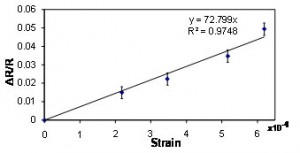Carbon Nanotube-based Piezoresistive MEMS Sensors
Due to their inherently small size and their high sensitivity to strain, carbon nanotube (CNT) based sensors offer the potential to overcome some of the current limitations in MEMS/NEMS sensing applications. However, a better understanding of what causes this high strain sensitivity is needed to design and manufacture high-performance sensor systems. A MEMS test structure was designed and microfabricated in order to measure the CNT gauge factor. As Figure 1 shows, this test structure consists of a fixed-fixed flexure beam with electrodes connected to the base of the flexure. The outer four sets of electrodes are connected to polysilicon piezoresistors while the inner two electrodes are left empty so that CNTs can be connected across them. These central electrodes are spaced 1μm apart. This architecture allows the strain in the flexure to be measured simultaneously by both the polysilicon and CNT piezoresistors. The center of the flexure has a locating hole where weights can be placed to load the structure and strain the CNTs. The CNTs are deposited onto these test flexures using dielectrophoresis. A low-noise-sensor system was setup to measure the gauge factor of the CNT resistor network. The CNT resistor network was incorporated into a DC Wheatstone bridge in a quarter bridge configuration. Using this setup, the gauge factor of the CNT resistor network was measured to be 73 9, as Figure 2 shows. The experimental measurement of the gauge factor of the CNT resistor network is within experimental error of the theoretical gauge factor of a CNT resistor network composed of randomly selected CNTs.
- Figure 1: CNT resistor network between two electrodes on the test structure.
- Figure 2: Measured change in resistance vs. strain for a CNT parallel-resistor network.

